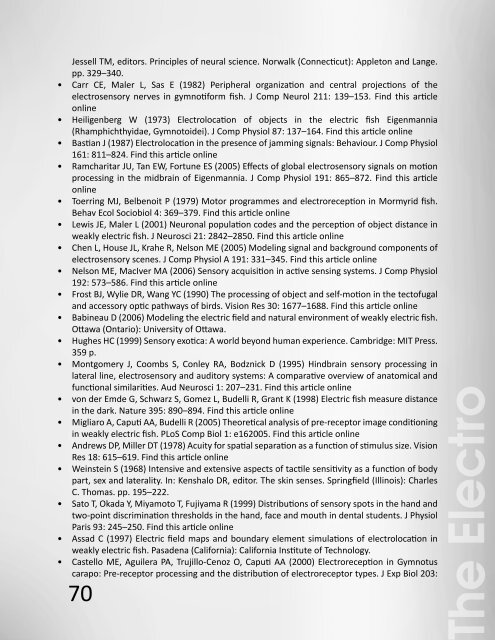The Electro Sense
The Electro Sense
The Electro Sense
- No tags were found...
You also want an ePaper? Increase the reach of your titles
YUMPU automatically turns print PDFs into web optimized ePapers that Google loves.
Jessell TM, editors. Principles of neural science. Norwalk (Connecticut): Appleton and Lange.pp. 329–340.• Carr CE, Maler L, Sas E (1982) Peripheral organization and central projections of theelectrosensory nerves in gymnotiform fish. J Comp Neurol 211: 139–153. Find this articleonline• Heiligenberg W (1973) <strong>Electro</strong>location of objects in the electric fish Eigenmannia(Rhamphichthyidae, Gymnotoidei). J Comp Physiol 87: 137–164. Find this article online• Bastian J (1987) <strong>Electro</strong>location in the presence of jamming signals: Behaviour. J Comp Physiol161: 811–824. Find this article online• Ramcharitar JU, Tan EW, Fortune ES (2005) Effects of global electrosensory signals on motionprocessing in the midbrain of Eigenmannia. J Comp Physiol 191: 865–872. Find this articleonline• Toerring MJ, Belbenoit P (1979) Motor programmes and electroreception in Mormyrid fish.Behav Ecol Sociobiol 4: 369–379. Find this article online• Lewis JE, Maler L (2001) Neuronal population codes and the perception of object distance inweakly electric fish. J Neurosci 21: 2842–2850. Find this article online• Chen L, House JL, Krahe R, Nelson ME (2005) Modeling signal and background components ofelectrosensory scenes. J Comp Physiol A 191: 331–345. Find this article online• Nelson ME, MacIver MA (2006) Sensory acquisition in active sensing systems. J Comp Physiol192: 573–586. Find this article online• Frost BJ, Wylie DR, Wang YC (1990) <strong>The</strong> processing of object and self-motion in the tectofugaland accessory optic pathways of birds. Vision Res 30: 1677–1688. Find this article online• Babineau D (2006) Modeling the electric field and natural environment of weakly electric fish.Ottawa (Ontario): University of Ottawa.• Hughes HC (1999) Sensory exotica: A world beyond human experience. Cambridge: MIT Press.359 p.• Montgomery J, Coombs S, Conley RA, Bodznick D (1995) Hindbrain sensory processing inlateral line, electrosensory and auditory systems: A comparative overview of anatomical andfunctional similarities. Aud Neurosci 1: 207–231. Find this article online• von der Emde G, Schwarz S, Gomez L, Budelli R, Grant K (1998) Electric fish measure distancein the dark. Nature 395: 890–894. Find this article online• Migliaro A, Caputi AA, Budelli R (2005) <strong>The</strong>oretical analysis of pre-receptor image conditioningin weakly electric fish. PLoS Comp Biol 1: e162005. Find this article online• Andrews DP, Miller DT (1978) Acuity for spatial separation as a function of stimulus size. VisionRes 18: 615–619. Find this article online• Weinstein S (1968) Intensive and extensive aspects of tactile sensitivity as a function of bodypart, sex and laterality. In: Kenshalo DR, editor. <strong>The</strong> skin senses. Springfield (Illinois): CharlesC. Thomas. pp. 195–222.• Sato T, Okada Y, Miyamoto T, Fujiyama R (1999) Distributions of sensory spots in the hand andtwo-point discrimination thresholds in the hand, face and mouth in dental students. J PhysiolParis 93: 245–250. Find this article online• Assad C (1997) Electric field maps and boundary element simulations of electrolocation inweakly electric fish. Pasadena (California): California Institute of Technology.• Castello ME, Aguilera PA, Trujillo-Cenoz O, Caputi AA (2000) <strong>Electro</strong>reception in Gymnotuscarapo: Pre-receptor processing and the distribution of electroreceptor types. J Exp Biol 203:<strong>The</strong> <strong>Electro</strong><strong>Sense</strong>3279–3287. Find this article online• Pereira AC, Centurion V, Caputi AA (2005) Contextual effects of small environments on theelectric images of objects and their brain evoked responses in weakly electric fish. J Exp Biol208: 961–972. Find this article online• von der Emde G (1993) <strong>The</strong> sensing of electrical capacitances by weakly electric mormyridfish: Effects of water conductivity. J Exp Biol 181: 157–173. Find this article online• Wojtenek W, Pei X, Wilkens LA (2001) Paddlefish strike at artificial dipoles simulating the weakelectric fields of planktonic prey. J Exp Biol 204: 1391–1399. Find this article online• Schwarz S, von der Emde G (2001) Distance discrimination during active electrolocation in theweakly electric fish Gnathonemus petersii. J Comp Physiol A 186: 1185–1197. Find this articleonline• Graff C, Kaminski G, Gresty M, Ohlmann T (2004) Fish perform spatial pattern recognition andabstraction by exclusive use of active electrocation. Curr Biol 14: 818–823. Find this articleonline• Nelson ME, MacIver MA (1999) Prey capture in the weakly electric fish Apteronotus albifrons:Sensory acquisition strategies and electrosensory consequences. J Exp Biol 202: 1195–1203.Find this article online• Blake R, Lee SH (2005) <strong>The</strong> role of temporal structure in human vision. Behav Cogn NeurosciRev 4: 21–42. Find this article online• Culling JF (2000) Auditory motion segregation: A limited analogy with vision. J Exp Psychol 26:1760–1769. Find this article online• Saberi K, Tirtabudi P, Petrosyan A, Perrott DR, Strybel TZ (2002) Concurrent motion detectionbased on dynamic changes in interaural delay. Hear Res 174: 149–157. Find this article online• Shumway CA (1989) Multiple electrosensory maps in the medulla of weakly electricgymnotiform fish. I. Physiological differences. J Neurosci 9: 4388–4399. Find this article online• Metzner W, Juranek J (1997) A sensory brain map for each behavior? Proc Natl Acad Sci U S A94: 14798–14803. Find this article online• Bell CC (2001) Memory-based expectations in electrosensory systems. Curr Opin Neurobiol11: 481–487. Find this article online• Bastian J (1999) Plasticity of feedback inputs in the apteronotid electrosensory system. J ExpBiol 202: 1327–1337. Find this article online• Chacron MJ, Maler L, Bastian J (2005) Feedback and feedforward control of frequency tuningto naturalistic stimuli. J Neurosci 25: 5521–5532. Find this article online• Fortune ES (2006) <strong>The</strong> decoding of electrosensory systems. Curr Opin Neurobiol 16: 474–480.Find this article online• Toerring MJ, Moller P (1984) Locomotor and electric displays associated with electrolocationduring exploratory behavior in mormyrid fish. Behav Brain Res 12: 291–306. Find this articleonline• Lannoo MJ, Lannoo SJ (1993) Why do electric fishes swim backwards? An hypothesis based ongymnotiform foraging behavior interpreted through sensory constraints. Environ Biol Fishes36: 157–165. Find this article online• Darian-Smith I (1982) Touch in primates. Annu Rev Psychol 33: 155–194. Find this article online• Nguyen QT, Kleinfeld D (2005) Positive feedback in a brainstem tactile sensorimotor loop.Neuron 45: 447–457. Find this article online• Poteser M, Kral K (1995) <strong>The</strong> significance of head movements in distance discrimination in70 71
















